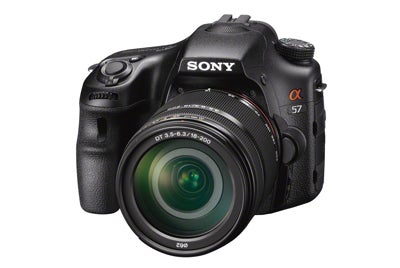Sony Alpha A57 Review
Sony Alpha A57 Review
Succeeding the acclaimed Alpha A55, the A57 marries an updated set of specifications with an enthusiast-oriented body. The What Digital Camera Sony Alpha A57 review finds out if the partnership is a success

Verdict
Pros
- Focusing performance, electronic level indicators, class-leading burst rate
Cons
- Handful of operational grievances, dated menu system, occasional underexposure
Key Specifications
- Review Price: £695
Sony’s SLT concept began life as little more than a minor deviation from the DSLR norm, with a fixed translucent mirror in place of the traditional reflex type, and an electronic viewfinder immediately polarising opinion. Today, however, SLT models, such as the Sony Alpha A57, constitute the majority of Sony’s Alpha range, and its here where new technologies are first surfacing.

Sony A57 review – Features
The latest addition to the Alpha family is the Sony Alpha A57, which technically replaces the well-regarded A55 model but externally resembles the enthusiast-level A65. It adheres to a similar idea as the A55, but pushes through a raft of minor improvements across all aspects of the specification set, while also debuting a couple innovative features, the likes of which we’ve come to expect from Sony.
One of these is Auto Portrait Framing, which crops a captured image of a person to a composition satisfying the rule of thirds. So, rather than have a subject in the centre of an image, the function will crop out a version where the subjects eyes are along one of the intersections defined by the rule. This is then interpolated back up to the resolution of the original image using Sony’s By Pixel Super Resolution Technology, and saved alongside the captured one.
The By Pixel Super Resolution Technology, which has featured in the company’s previous Cyber-Shot models, is also at the heart of the 2x Clear Image Zoom feature, which is said to double the effective length of a mounted lens while maintaining the camera’s full resolution.
On that subject, the Sony Alpha A57 makes use of the NEX 5N‘s 16.1MP Exmor R CMOS sensor; although this offers no advantage in resolution over the 16MP sensor found in the A55, its partnering with the latest generation BIONZ processor is said to nevertheless bring benefits with regards to image quality.
As an SLT model, the Sony Alpha A57 offers an electronic viewfinder in place of an optical one, with 1.44million dots and a 100% view of the scene. In addition to its minor increase in resolution over the A55’s finder, it also employs revised optical components which allow a variable eyepoint from 23.1mm and 25.2mm. The 3in LCD screen, meanwhile, is sized to the 4:3 aspect ratio and equipped with 921,000 dots, with the option of pivoting the display around a base joint for less conventional capture.
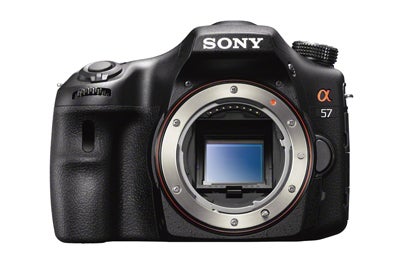
Sony has made an number of additional changes on the inside of the Sony Alpha A57, some of which may not be apparent if simply glancing at the camera’s specifications. The 15-point AF module, for example, remains from the A55, although it’s claimed to benefit from revised Object Tracking AF algorithms to keep a lock on moving subjects.
The Sony Alpha A57’s burst mode has also been increased to offer 8fps as standard, and 10fps in the Continuous Priority AE option which keeps the aperture constant between frames. This mode also adds a further 12fps JPEG-only option in conjunction with the camera’s Tele Zoom, whereby a 1.4x crop of the centre of the frame is captured (at a reduced resolution) with autofocus adjusted between frames.
The omission of the A55’s GPS unit may seem odd on an upgraded model, although this does at least help conserve power.
The use of the same NP-FM500H battery as the A65 is also said to allow the camera to last for a respectable 590 frames when using the LCD screen, and 40 less with the viewfinder, although such figures are always subject to a range of other variables. As with other Alpha models, the Sony Alpha A57 maintains support for a range of Memory Stick and SD media, including the latest SDXC format.
Design
Sony Alpha A57 review – Design
Sony has stated that it sought to improve on the ergonomics of the A55, and a side by side comparison shows the new model as one targetted at a more enthusiast audience. The more substantial grip with depressions for both middle and ring fingers should easily accommodate hands of all sizes, while there’s ample thumb space on the rear in between the various controls. It’s also welcome to see the controls which were positioned on a slope between the rear and top-plate on the A55 are now more conveniently facing the user at a steeper and more comfortable angle.
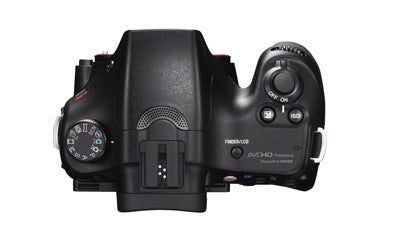
The quality of the camera’s construction is more than satisfactory, and in line with other cameras around this price point, such as Nikon’s D5100 and Canon’s EOS 600D. As regards button and control positioning, there’s little to dislike: the mode dial is sufficiently tall and its side tactile for easy operation, while the command dial also protrudes out far enough to be easily turned. The only gripe here concerns the power collar around the shutter release button, which would benefit from being more distinct, either in size or texture.
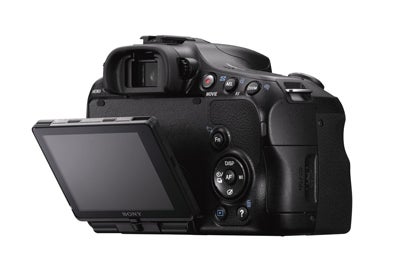
All buttons are clearly labelled in either white or blue text, and aside from the lesser-used ‘?’ control, all press positively into the camera. Digging around the menu reveals that many of these can have their functions customised to taste, which helps if you find yourself dissatisfied with the default set-up. Admittedly, the camera isn’t as laden with buttons as other models, and there’s ample space on the top plate for a further control of some kind – nevertheless, anything important which doesn’t fall to hand can be quickly accessed through the ‘Fn’ control.
Performance
Sony Alpha A57 review – Performance
The main benefit of the SLT technology is that the camera can use phase detection AF regardless of whether the viewfinder of the LCD screen is used. And, with fifteen points in the centre of the frame – three of which being cross-type – it comes as little surprise that in the majority of occasions focus is quickly achieved. The concentration of AF points in the centre of the frame, however, means that peripheral areas are left uncovered, meaning the only way to achieve focus on subjects positioned here is by focusing and recomposing (which isn’t ideal for subjects close up) or through manually focusing.
The Object Tracking AF function also suffers slightly because of this; if the subject strays towards the peripheries of the frame the camera will keep a lock on the subject, although it will only focus on it if this box finds itself in the area of the fifteen focusing points. Otherwise, unhelpfully, the camera will simply disregard the Object Tracking box and focus using its fifteen points. Of course, should the subject be centrally located there isn’t an issue, as the Object Tracking function manages to keep up well with its movements, only being distracted when bright lights or similarly-coloured subjects enter the frame.

Once enabled the Auto Portrait Function only requires a subject to be picked out by Face Detection, before the result is cropped and scaled back up to the the camera’s full pixel count. Sony makes grand claims about the effectiveness of the By Pixel Super Resolution Technology used in this process, and the results show this to be more than just marketing puffery: when the face occupies a significant proportion of the frame, the camera manages to scale the cropped result back with surprisingly good results.
Attaining correct focus here is critical, however, as even a slight blur is magnified upon interpolation. Still, while effective when used correctly, it doesn’t feel as though such a feature belongs here in the same way as it would on a Cyber-Shot model. Furthermore, its implementation is puzzling and inconvenient; you either need to have the camera permanently set to JPEG capture (as it doesn’t work in Raw), or activate it only when you don’t feel your compositional skills are good enough. This isn’t a feature which encourages more considered photography.
For the most part the electronic viewfinder is perfectly capable of fulfilling its role, and the increase in resolution over the a55 is a positive move. Although a comparison with the more expensive A65 shows that camera’s viewfinder to be better in many areas, the A57’s finder is still detailed enough for all viewing and focusing. It’s reasonable to suspect that the increasing performance of such devices is slowly converting even hardened optical viewfinder aficionados, and the benefits of having so much information in the display can be incredibly useful.
Nevertheless, working in high-contrast conditions highlights how such viewfinders are not ideal for all lighting conditions, with the narrow dynamic range and high-contrast feed sometimes causing shadow or highlight details – details which are captured in the image – to be lost. Those who envisage themselves using the camera mainly in sunnier conditions are advised to consider this, although those often finding themselves shooting in darker conditions have the obvious advantage of a correctly exposed viewfinder feed, where an optical viewfinder would remain dark.
The SLT system on which the camera is constructed means that composition and capture through the LCD screen is far more practical than on traditional DSLR models. As with practically any other LCD screen it can be difficult to view in bright sunlight, to the point of not being usable, although the 921,000dot resolution allows images to be viewed in more than satisfactory detail, while the viewing angle shows itself to being particularly good when lighting conditions are more balanced.
Of course, being a vari-angle LCD screen the latter point is less of an
issue than with fixed-screen models, although many will no doubt
appreciate this when the screen is set to its default position. The only
annoyance here is that when viewing in bright sunlight the tendency to
shield the screen with the hand often fools the viewfinder sensor to
think that the user’s face is approaching, thus turning off the LCD. This
sensor can be disabled, but if you tend to alternate between the
two this is something you may just have to put up with (or alternatively, keep pressing the Finder/LCD button on the top plate).
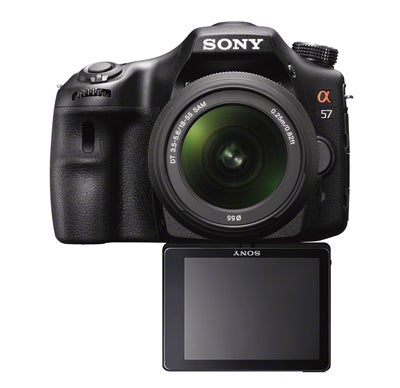
Sadly, a handful of issues present in previous Alpha models have made their way onto the A57. Should a function not be available when shooting Raw images, for example, the camera will explain this without giving you the immediate (and logical) option to switch to JPEG. This happens repeatedly, from the Multi-Frame Noise Reduction option to the Auto Portrait Framing and the Smart Zoom mode. The menu system is also due a refresh, principally because the black/orange colour palette used throughout makes it unnecessarily more difficult to jump to a specific locations, something which is remedied quite simply with a colour-coded system found in many rival models.
Image Quality
Sony Alpha A57 review – Image Quality
For the most part the A57’s metering system is sound, although it appears easily led into underexposure. Those capturing JPEGs may be inclined to leave on the DRO feature, as in such circumstances it helps to lift shadows to a more balanced exposure – otherwise, exposure compensation may be easily dialed in when required. In more balanced conditions there’s little to fault.
There’s also little reason to venture into the white balance presets, as most of the time the auto white balance system gets things right. In natural lighting the system is perfectly capable of assessing and reproducing most scenes accurately, and in conjunction with an appropriate Creative Style option can deliver images with brilliant colour straight out of the camera. The real test for any auto white balance system is under artificial light, and it’s here where things can come undone. Sometimes the auto system is surprisingly accurate (even under mixtures of artificial light), although on other ocassions (particularly under incandescent sources) it’s way off the more faithful reproductions achieved with the relevant preset.
The Standard Creative Style proves itself to being perfectly appropriate for many scenes, while the other options, if used correctly, also all find their use. The only instances where colours suffer are in high-ISO JPEG images, largely thanks to the noise reduction system, which cannot be disabled (only varied in intensity). Those processing Raw images may have better luck removing chroma noise before applying the various colour corrections necessary to bring the image back to life.
Despite some texture at lower sensitivities, noise doesn’t become too great an issue until around ISO 1600 where details begin to be increasingly obscured. Images captured on the JPEG-only ISO 25,600 option struggle to show any significant detail, as noise reduction cannot be disabled here. A comparison with the A65, however, showsthe A57’s noise control to be marginally – but noticeably – better, which isn’t particularly surprising given the larger photosites on the A57’s sensor.
The kit lens supplied with the camera is small, lightweight and, for the most part, optically adequate, but against a high-resolution sensor it becomes easier to see its flaws. Detail improves once the aperture is stopped down, although when an alternative optic is used it becomes clear just how much detail the sensor is capable of resolving. At low sensitivites this is impressive, but noise reduction soon steps as sensitivity is increase. As always, low noise reduction or Raw post-processing is the best way to go.
Although the difference is slight, JPEG images do exhibit better sharpness than corresponding Raw files. Natural subjects show no unsightly sharpening artefacts, although a touch of additional sharpness in post-production does define details without any ill effects. It’s perhaps better to err on the side of caution than over-processing, so it’s difficult to fault the processing here. It’s only at higher sensitivities where things fall apart, as the noise reduction system does what it’s meant to, but not without leaving the familiar watercolour blotchiness. Colour in JPEGs is also good, with some of the casts over neutral areas in certain Raw images rectified.
The a57 records full HD video at 50p using the AVCHD 2.0 codec. When a good optic is used the level of detail in video recordings is excellent, with the AF system immediately bringing subjects into focus. Footage is very smooth and the SteadyShot Inside system noticeably helps to keep the feed stable, while sound quality is also decent with only a little ambient noise picked up. In fact, the only noticeable issue is aliasing when capturing very fine subjects and architectural details, although this is often a problem with such subjects.
Value and Verdict
Sony Alpha A57 review – Value
With its 18-55mm kit lens the A57 is currently priced at just under £700, and around £80 less for just the body. With the outgoing A55 being less available, the closest model for comparison would be the A65 which is only around £70 dearer. Reflected in this premium is the A65’s 24.3MP sensor, 2.36million dot OLED viewfinder and GPS system, alongside a handful of smaller differences, all of which makes the A65 appear as the better value model. Once the A57 has spent as long on the market as that model, however, its price may descend to a more competitive point. Both two models are competitively specified when compared with their immediate peers, though, value for money being something of a hallmark for the Alpha line.
Sony Alpha A57 review – Verdict
Aside from its more enthusiast-focused design, the A57 can’t be said to be a significant update over the A55 it replaces. True, this isn’t entirely a bad thing, as it shares many of that camera’s positive attributes, from its snappy focusing performance and reliable image and video quality, to the handful of features which make it as enjoyable to use as the camera is capable. Anyone looking for a camera which marries entry-level simplicity with enthusiast control should, without question, add it to their shortlist along with the similarly-priced Nikon D5100 and Canon EOS 600D. Nevertheless, while it’s welcome to see improvements to the camera’s burst shooting functionality and sensitivity span, it’s disappointing that basic issues which impede operability continue to be ignored. Despite this, the A57 is still a capable and cheaper alternative to the A65, and one likely to appeal to those who’d take advantage of its slightly better noise performance. In its own right it earns itself a warm recommendation, although those interested in one are advised to look closely at the other too.
Trusted Score
Score in detail
-
Value 9
-
Design 9
-
Features 10
-
Image Quality 9
-
Performance 9








